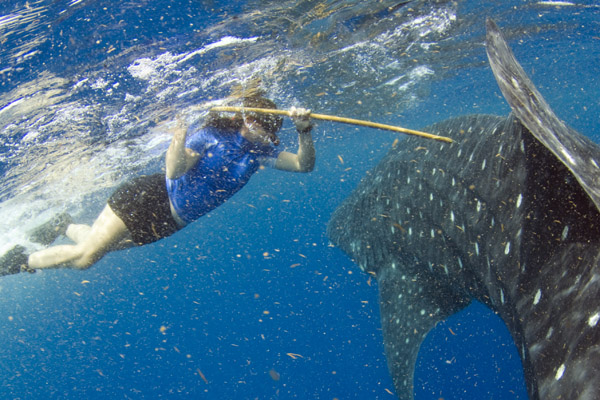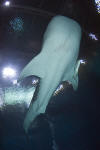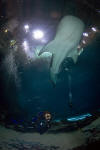|
The North American Shark Diving Tour - Whale Shark Tagging Expedition First published in Shark Diver Magazine November 2009
Road trips are good for the soul. But, if you stay on the road long enough, one of two things will eventually happen; either you�ll go so far and change so much that you�ll never really make it back to where you came from or the worries you left behind will eventually track you down and drag you back to reality. After our Atlantic sharpnose shoot in Mississippi, the tour had a few set backs. I received word that my dad was fading fast so we drove down to Miami and flew to London to be with him. When we got back two weeks later, our camper was shaking so badly that I thought I�d thrown a piston. We left it in the capable hands of a german VW mechanic and took a rental car all the way back to Leeville, Louisiana, arriving just in time to jump on a fishing boat for a week long whale shark tagging expedition. The 67ft long Norman B is reputedly the pride of the Louisiana fishing fleet and it is quite comfy in a primitive kind of way but it wasn�t until we were far out at sea with Dr Hoffmayer, his assistant Jennifer, German Film Maker Ulf Marquardt and four deep sea fishermen that we noticed that there was no toilet on board. Instead, there was a rustic shower cubicle and a bucket. Ah, the sacrifices we make for science. During that memorable week at sea we saw a dozen or so whale sharks and tagged three with satellite transmitters. Claire personally tagged one of the sharks and I documented everything for posterity and took i.d. shots for the Ecocean Whale Shark Photo-identification Library. I also broke a rib pulling myself back into the pursuit boat which made the rest of the voyage a little uncomfortable. After days on end of staring at empty sun spangled water we began seeing fins that weren�t really there. For a change of pace, we motored over to one of the distant oil rigs and did a little chumming. To the bewilderment of the fishermen, Claire and I jumped in to shoot a gathering school of silkies and a pair of very shy spinner sharks that kept swimming back and forth in deeper water. Spinners are notoriously difficult to approach but with a little patience I was able to free dive close enough to get a few snapshots. Under another rig we also shot the first live images (as far as we know) of a Gulf of Mexico smoothhound shark. We were very lucky to find one because the gulf smoothhound lives in an area just a few hundred miles wide. Once back on land, we retraced our steps to south Florida and picked up the camper. We were planning to join our buddy Lawrence Groth for some hammerhead diving off of Fort Meyers and then hook up with a sawfish researcher but the weather was so abysmal that we decided to cut and run. Panama City was a different story. While free diving along the piers we found some Atlantic Guitarfish, Bancroft�s electric rays, a small group of mobulas and a resident nurse shark. For three days we bobbed around shooting everything that moved and then took of for North Carolina to dive with sandtiger sharks. Unfortunately, 20kms up the road fate intervened. As we drove through Destin a small check valve exploded on my engine and the escaping hot air welded my throttle cable to its casing. We limped into a garage and ordered another rental. The repair costs were painful but the hold up was far more excruciating. Apparently, VW camper spares have to come via Alpha Centuri so we bought a pup tent and sat in a campground for two weeks waiting for things to improve. They didn�t. The next day (because of rising water temps) a thick layer of bright green algae began collecting near the shore. Before long it had completely covered every inch of sand making further snorkeling impossible. After a week of being a dartboard for mosquitoes I couldn�t take it anymore. With the gulf out of commission there was only one thing to do. I called the Georgia Aquarium and inquired about their shark tank dive. After a little schmoozing, they agreed to let me bring my camera along and a few days later Claire and I jumped in the rental and drove up to land locked Atlanta.
At first glance Atlanta may not seem like a shark diving Mecca but a dip in the Ocean Voyager exhibit is a quick way to tick off 6 or 7 shark and ray species that you unlikely to ever see in the wild. And, if that in itself isn't enough of a draw, topping the bill in the football field sized tank are four enormous whale sharks which were transported here from Taiwan in the bad old days before the Taiwanese banned the harvesting of whale sharks for consumption. As whale sharks go, these ones are still relatively small but they are impressive none the less and with a regular diet of krill (or fish pellets that do the same job) they are growing fast. Sadly, two of the original sharks died from a reaction to an antibiotic but these have been replaced and all four of the present sharks appear to be in good shape.
Claire and I listened intently to the dive briefings and watched the video that all potential divers get before entering the tank and then we quietly slipped into the crystal clear water and descended to the sand. As soon as our entourage of divemasters were happy with our buoyancy we drifted into the centre of the upper bowl of the tank and started shooting. This half of the exhibit consists of a large shallow area devoid of obstructions where different species of sharks and rays can swim around unimpeded or sprawl on the bottom as they see fit.
While the other divers marveled at the enormous whale sharks
gliding overhead, I made a beeline
Unfortunately, their saws which they use to slash into schools of fish when feeding, have also become their downfall. Sawfish often get inextricably tangled in fishing nets and even if the nets are recovered before the sawfish die, many fishermen would rather kill them than risk injury trying to extricate them unharmed. There are also a few unscrupulous fishermen that actually target sawfish and hack off their saws to sell as curios on the black market. Consequently they are now critically endangered worldwide. There are two species of sawfish in the Atlanta Aquarium: green and largetooth. The largetooth sawfish are impressive in their own right but the green sawfish are impossible to ignore. Under the soft lights of the tank they appear to radiate a subtle golden light. Sawfish are not the only large rays in the tank. There are a number of alien looking bowmouth guitarfish and some enormous shark rays. All of these are accustomed to close encounters with divers and snorkelers so it is possible to plonk down on the sand right next them and really study them in detail; not something that is easily accomplished in the wild. Other rarities include fantastically patterned leopard whiptail rays which I have tried to shoot in Western Australia but could not get anywhere near before they exploded away in a cloud of sand, and southern stingrays, pink whiptail rays, small groups of cownose rays and amazingly, a manta ray!
As for sharks, during the dive we were regularly buzzed by great hammerheads, zebra sharks and sandbar sharks. Sandtigers floated around as only sandtigers can and a number of wobbegongs (both tasselled and spotted) sprawled lazily on rocks and on the acrylic tunnels that were full of wide eyed spectators. After snapping away in the upper bowl for a while we drifted down into the deeper half of the tank and checked out some of the sharks and rays that prefer to stay in that area. As instructed, we did our best to remain in the lower third of the water column so that the whale sharks could swim around at the surface in peace. The tank was designed so that the whale sharks have enough room to turn, swim towards the far end of the tank for a while and then glide for a bit. Studies at other aquariums have shown that this is important because the sharks do better if they can rest for a short time before they have to turn again.
The whole time that I was swimming around I was trying to gauge whether the tank's inhabitants were suffering from overcrowding. I'm still not totally sure but I didn't see any sharks or rays having trouble avoiding each other. Also, very few of the animals had grazes on their noses and pectoral fins, which would be a sure sign that they are not comfortable in the tank. With so much eye candy, the dive was over long before we were ready to surface. We reluctantly exited and cleaned up. The staff then presented us with goody bags full of sharky stuff and we sat down with Dr Bruce Carlson who filled us in on some of the research that the Georgia Aquarium is funding.
Bruce explained that the aquarium is involved with a number of projects including a long term study of the yearly whale shark aggregation near Holbox, Mexico. The Holbox herd is the largest known annual gathering of whale sharks in the world. In conjunction with Bob Hueter from Mote Marine Laboratory in Florida, the aquarium has been tagging and measuring as many whale sharks as possible each summer to try to figure out where they migrate to.
We spent the rest of our day roaming the halls of the aquarium and people watching. Whether you're pro-aquarium or not there is no denying how engrossed everyone was with the shark tank and that is a lot better than seeing people drawn to a large shark carcass hanging from the gallows on a fishing pier. Armed with a fist full of new species we finally picked up our camper and drove north.
Author: Andy Murch Andy is a Photojournalist and outspoken conservationist specializing in images of sharks and rays.
RETURN TO SHARK STORIES MAIN PAGE
|


































